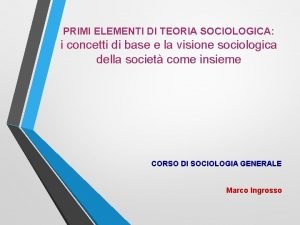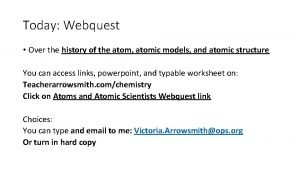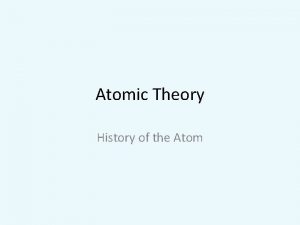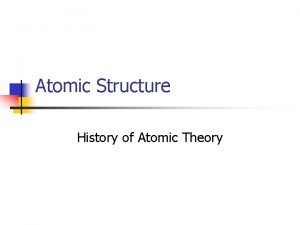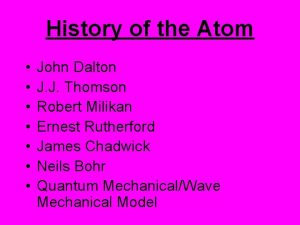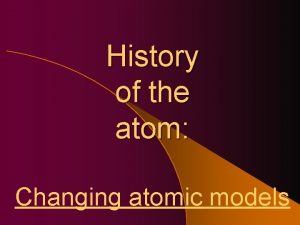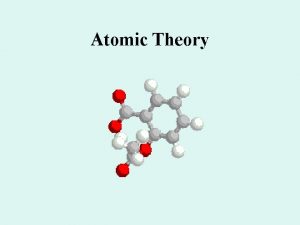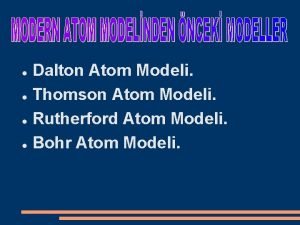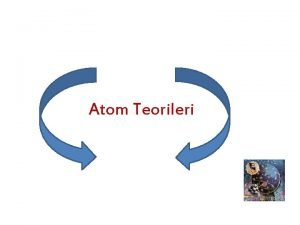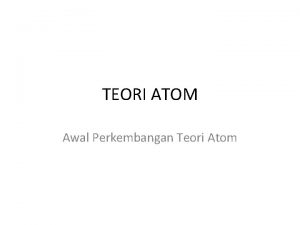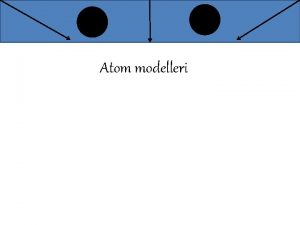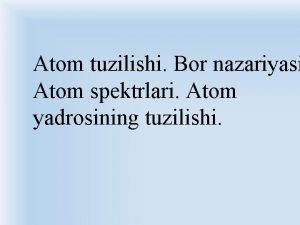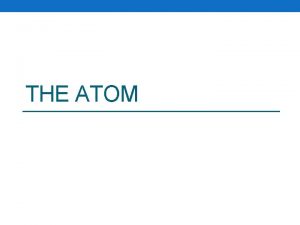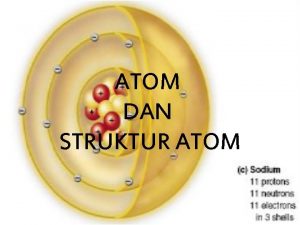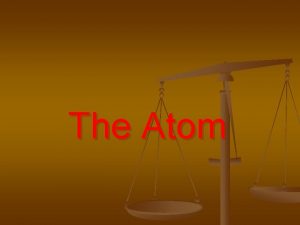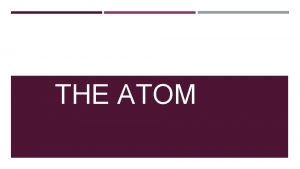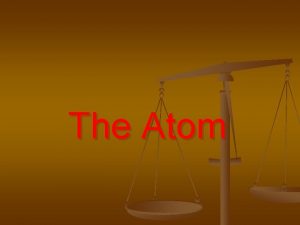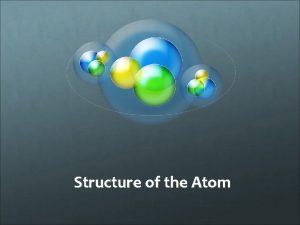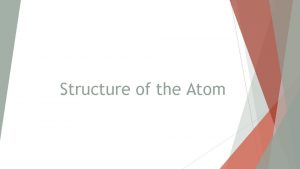C ANCHETA ECE 0042030 HISTORY OF THE ATOM






















- Slides: 22

C. ANCHETA ECE 0042030

HISTORY OF THE ATOM 460 BC Democritus develops the idea of atoms he pounded up materials in his pestle and mortar until he had reduced them to smaller and smaller particles which he called ATOMA (greek for indivisible)

HISTORY OF THE ATOM 1808 John Dalton suggested that all matter was made up of tiny spheres that were able to bounce around with perfect elasticity and called them ATOMS

HISTORY OF THE ATOM 1898 Joseph John Thompson found that atoms could sometimes eject a far smaller negative particle which he called an ELECTRON

HISTORY OF THE ATOM 1904 Thompson develops the idea that an atom was made up of electrons scattered unevenly within an elastic sphere surrounded by a soup of positive charge to balance the electron's charge like plums surrounded by pudding. PLUM PUDDING MODEL

HISTORY OF THE ATOM 1910 Ernest Rutherford oversaw Geiger and Marsden carrying out his famous experiment. they fired Helium nuclei at a piece of gold foil which was only a few atoms thick. they found that although most of them passed through. About 1 in 10, 000 hit

HISTORY OF THE ATOM helium nuclei gold foil helium nuclei They found that while most of the helium nuclei passed through the foil, a small number were deflected and, to their surprise, some helium nuclei bounced straight back.

HISTORY OF THE ATOM Rutherford’s new evidence allowed him to propose a more detailed model with a central nucleus. He suggested that the positive charge was all in a central nucleus. With this holding the electrons in place by electrical attraction However, this was not the end of the story.

HISTORY OF THE ATOM 1913 Niels Bohr studied under Rutherford at the Victoria University in Manchester. Bohr refined Rutherford's idea by adding that the electrons were in orbits. Rather like planets orbiting the sun. With each orbit only able to contain a set number of electrons.

Bohr’s Atom electrons in orbits nucleus

HELIUM ATOM Shell proton + - N N + electron What do these particles consist of? - neutron

ATOMIC STRUCTURE Particle Charge Mass proton + ve charge 1 neutron No charge 1 electron -ve charge nil

ATOMIC STRUCTURE He 2 4 Atomic number the number of protons in an atom Atomic mass the number of protons and neutrons in an atom number of electrons = number of protons

Subatomic Particles Particle Charge Mass (g) Location Electron (e-) -1 9. 11 x 10 -28 Electron cloud Proton (p+) +1 1. 67 x 10 -24 Nucleus Neutron (no) 0 1. 67 x 10 -24 Nucleus

ATOMIC STRUCTURE Electrons are arranged in Energy Levels or Shells around the nucleus of an atom. • first shell a maximum of 2 electrons • second shell a maximum of 8 electrons • third shell a maximum of 18 electrons

ATOMIC STRUCTURE There are two ways to represent the atomic structure of an element or compound; 1. 2. Electronic Configuration Dot & Cross Diagrams

ELECTRONIC CONFIGURATION With electronic configuration elements are represented numerically by the number of electrons in their shells and number of shells. For example; Nitrogen 2 in 1 st shell 5 in 2 nd shell configuration = 2 , 5 2 + 5 = 7 N 7 14

ELECTRONIC CONFIGURATION Write the electronic configuration for the following elements; a) Ca 20 b) Na 40 2, 8, 10 d) Cl 17 35 2, 8, 7 11 23 c) 2, 8, 1 e) Si 14 28 2, 8, 4 O 8 16 2, 6 f) B 5 11 2, 3

DOT & CROSS DIAGRAMS With Dot & Cross diagrams elements and compounds are represented by Dots or Crosses to show electrons, and circles to show the shells. For example; X Nitrogen X X N XX X X N 7 14

DOT & CROSS DIAGRAMS Draw the Dot & Cross diagrams for the following elements; X 8 17 X a) O b) Cl 35 16 X X X X X Cl X X X O X X X X X

SUMMARY 1. The Atomic Number of an atom = number of protons in the nucleus. 2. The Atomic Mass of an atom = number of Protons + Neutrons in the nucleus. 3. The number of Protons = Number of Electrons. 4. Electrons orbit the nucleus in shells. 5. Each shell can only carry a set number of electrons.

This powerpoint was kindly donated to www. worldofteaching. com http: //www. worldofteaching. com is home to over a thousand powerpoints submitted by teachers. This is a completely free site and requires no registration. Please visit and I hope it will help in your teaching.
 Model de chestionar sociologic
Model de chestionar sociologic Ce intrebari se pun la o ancheta sociala
Ce intrebari se pun la o ancheta sociala Ancheta sociala
Ancheta sociala Ancheta sociologica
Ancheta sociologica The structure of the atom section 2 defining the atom
The structure of the atom section 2 defining the atom Gambar teori atom
Gambar teori atom Atomic history webquest
Atomic history webquest 1930 modern atom teorisi
1930 modern atom teorisi History of the atom scientists
History of the atom scientists History of the atom john dalton
History of the atom john dalton History of the atom democritus
History of the atom democritus John dalton billiard ball model
John dalton billiard ball model Atomic theory graphic organizer
Atomic theory graphic organizer Hình ảnh bộ gõ cơ thể búng tay
Hình ảnh bộ gõ cơ thể búng tay Bổ thể
Bổ thể Tỉ lệ cơ thể trẻ em
Tỉ lệ cơ thể trẻ em Voi kéo gỗ như thế nào
Voi kéo gỗ như thế nào Tư thế worms-breton
Tư thế worms-breton Chúa yêu trần thế alleluia
Chúa yêu trần thế alleluia Kể tên các môn thể thao
Kể tên các môn thể thao Thế nào là hệ số cao nhất
Thế nào là hệ số cao nhất Các châu lục và đại dương trên thế giới
Các châu lục và đại dương trên thế giới


